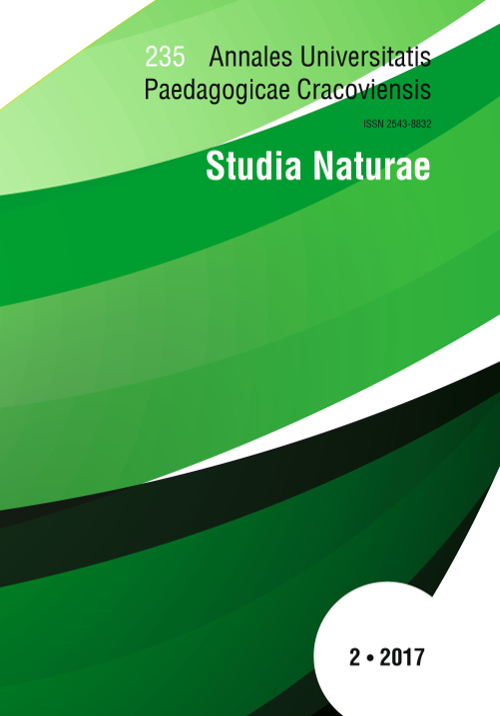A record of Silene viscaria (L.) Jess. (Caryophyllaceae) with achromatic flowers in the Mordovia State Nature Reserve (Central Russia)
DOI:
https://doi.org/10.24917/25438832.2.8Keywords:
achromatism, flower colour, morphological features, plant population, RussiaAbstract
Silene viscaria (L.) Jess. is a common species of Central Russian flora. It has attractive purple, crimson, or darkpink inflorescences. Some literature sources indicate the possibility of white-colour flowers. However, there are no reliable published evidences of these cases. In this report, a record of S. viscaria plants with achromatic, white, flowers at the southern border of the Mordovia State Nature Reserve is presented. Some morphological traits of flowering individuals were measured: the height of reproductive individuals, the number of whorls of lateral branches per an inflorescence, the number of flowers per an inflorescence, the length of an inflorescence, and the percentage of an inflorescence length from a flowering plants height. Data on the flora accompanying S. viscaria are presented. As a result, no significant differences between plants with achromatic flowers and plants with coloured flowers have been found. However, the height of white-flower individuals was slightly higher. We suggest accumulating data on a phenomenon of the flower’s achromatism amongst different groups of plants in order to try to understand the frequency of this phenomenon and perhaps its impact on plants biology.
Downloads
Metrics
References
Aleksandrova, V.D. (1964). The study of changes of vegetation cover. In: E.M. Lavrenko, A.A. Korchagina (eds.), Field geobotany. Moscow–Leningrad: Nauka, 399–447. [In Russian]
Binkenstein, J., Schaefer, H.M. (2015). Flower colours in temperate forest and grassland habitats: a comparative study. Arthropod-Plant Interactions, 9, 289–299. https://doi.org/10.1007/s11829-015-9369-9
Clapham, A.R., Tutin, T.G., Warburg, E.F. (1981). Flora of the British Isles. London: Cambridge University Press.
Czarna, A. (2006). Albinotic flowers in plants widly growing on the area of the Wielkopolska Lowland. Rocznik Akademii Rolniczej w Poznaniu, 378, 37–43.
Dyer, A.G., Rosa, M.G., Reser, D.H. (2008). Honeybees can recognise images of complex natural scenes for use as potential landmarks. Journal of Experimental Biology, 211(8), 1180–1186. https://doi.org/10.1242/jeb.016683
Euro+Med. (2006–2011). Euro+Med PlantBase – the information resource for Euro-Mediterranean plant diversity. http://ww2.bgbm.org/EuroPlusMed/
Frajman, B., Thollesson, M., Oxelman, B. (2013). Taxonomic revision of Atocion and Viscaria (Sileneae, Caryophyllaceae). Botanical Journal of the Linnean Society, 173(2), 194–210. https://doi.org/ 10.1111/boj.12090
Griesbach, R.J. (1979). The albino form of Epipactis helleborine. American Orchid Society Bulletin, 48(8), 808–809.
Gubanov, I.A., Kiseleva, K.V., Novikov, V.S., Tikhomirov, V.N. (2003). Illustrated determinants of plants of the Middle Russia 2: Angiosperms (Dicotyledons: dialypetalous). Moscow: KMK Scientific Press Ltd., Institute of Technological Researches. [In Russian]
Hammer, Ø., Harper, D.A.T., Ryan, P.D. (2001). PAST: Paleontological statistics software pack-age for education and data analysis. Palaeontologia Electronica, 4(1), 1–9. http://palaeo-electronica.org/2001_1/past/past.pdf
Hempel de Ibarra, N., Langridge, K.V, Vorobyev, M. (2015). More than colour attraction: behavioural functions of flower patterns. Current Opinion in Insect Science, 12, 64–70.
Jakubska, A., Schmidt, I. (2005). Chlorophyll-free form of Epipactis albensis Novkov et Rydlo (Orchidaceae, Neottieae) in the Skarpa Storczyków Nature Reserve near Orsk (Lover Silesia, Poland). Acta Botanica Silesiaca, 2, 151–154.
Jalas, J., Suominen, J. (1986). Atlas Florae Europaeae, 7. Caryophyllaceae (Silenoideae). Helsinki: Committee for Mapping the Flora of Europe and Societas Biologica Fennica Vanamo.
Jennersten, O. (1988). Pollination of Viscaria vulgaris (Caryophyllaceae): the contributions of diurnal and nocturnal insects to seed set and seed predation. Oikos, 52, 319–327. https://doi.org/10.2307/3565205
Khapugin, A.A., Vargot, E.V., Chugunov, G.G. (2014). Research methods of vegetative cover of terrestrial ecosystems. In: L.V. Egorov, A.B. Ruchin, A.A. Khapugin, O.N. Artaev (eds.), Methods of field environmental research. Chapter 1. Saransk; Pushta, 4–42. [In Russian]
Kohns, P., Schneider, P. (1993). Epipactis muelleri Godfery var. chlorotica. Die Orchidee, 44(2), 104–105. [In German]
Kurtto, A., Wesenberg, J. (2001). Viscaria Bernh. In: B. Jonsell (ed.), Flora Nordica, 2. Stockholm: The Bergius Foundation, The Royal Swedish Academy of Sciences, 172–175.
Miller, R., Owens, S.J., Rørslett, B. (2011). Plants and colour: Flowers and pollination. Optics & LaserTechnology, 43, 282–294. https://doi.org/10.1016/j.optlastec.2008.12.018
Morton, J.K. (2005). Silene. In: Flora of North America Editorial Committee (ed.), Flora of North America North of Mexico, 5. New York & Oxford: Oxford University Press, 166–214.
Selosse, M.A., Faccio, A., Scappaticci, G., Bonfante, P. (2004). Chlorophyllous and achlorophyllous specimens of Epipactis microphylla (Neottieae, Orchidaceae) are associated with ectomycorrhizal septomycetes, including truffles. Microbial Ecology, 47(4), 416–426. https://doi.org/10.1007/s00248-003-2034-3
Śliwiński, M., Jakubska-Busse, A. (2010). Albinotyczne kwiaty i formy roślin. Zielona Planeta, 2(89), 9–10.
The Plant List. A working list of plant species (2013). The Plant List. Version 1.1. http://www.theplantlist.org/
Trudell, S.A., Rygiewicz, P.T., Edmonds, R.L. (2003). Nitrogen and carbon stable isotope abundances support the mycoheterotrophic nature and host-specificity of certain achlorophyllous plants. New Phytologist, 160, 391-401. https://doi.org/10.1046/j.1469-8137.2003.00876.x

